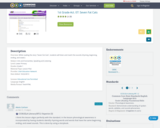
Overview: While reading the story "Seven Fat Cats", students will listen and match the sounds (rhyming, beginning, ending, and vowel.)
- Subject:
- English Language Arts
- Speaking and Listening
- Material Type:
- Lesson Plan
- Date Added:
- 05/12/2021

Overview: While reading the story "Seven Fat Cats", students will listen and match the sounds (rhyming, beginning, ending, and vowel.)
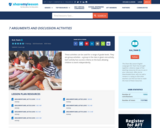
These activities can be used for a range of grade levels. They are group activities - a group in the class is given one activity. Each activity has success criteria on the back allowing children to work independently.
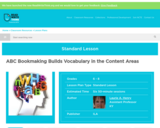
V is for vocabulary. A content area unit provides the theme for a specialized ABC book, as students select, research, define, and illustrate a word for each alphabet letter.
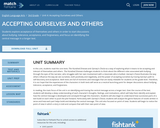
In this unit, students read the core texts The Hundred Dresses and Garvey’s Choice as a way of exploring what it means to be accepting and tolerant of themselves and others. The Hundred Dresses challenges students to think about the different roles associated with bullying through the eyes of the narrator, who struggles with her own involvement with a classmate who is bullied. Garvey’s Choice illustrates the way others influence the way we see ourselves, both positively and negatively, and the power of accepting ourselves by tracing Garvey’s path to self-discovery and acceptance. Both texts are full of moments and messages that are easily relatable for students at this grade level. Therefore, it is our hope that the experiences of the characters in both texts will serve as a neutral launching point for deeper discussions about bullying, tolerance, acceptance, and forgiveness.
In reading, the main focus of the unit is on identifying and tracing the central message across a longer text. Over the course of the text, students will develop a deep understanding of each character’s thoughts, feelings, and motivations, which will help them identify and explain how the central message is developed and conveyed through the characters. Students will also begin to understand how successive parts of a text build on each other to push the plot forward. Particularly with Garvey’s Choice, students will analyze the genre features of novels written in verse and how each part helps build and develop the central message. This unit also focused on point of view. Students will begin to notice the point of view in which a story is told and compare that with their own point of view.
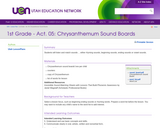
Students will listen and match sounds ... either rhyming sounds, beginning sounds, ending sounds or vowel sounds.
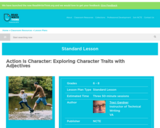
Students must "become" a character in a novel in order to describe themselves and other characters using powerful adjectives.
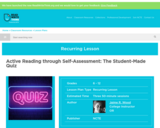
This recurring lesson encourages students to comprehend their reading through inquiry and collaboration. They choose important quotations from the text and work in groups to formulate "quiz" questions that their peers will answer.
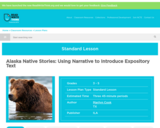
Tradition and technology come together in this lesson in which students learn about Alaskan animals through Native American tales and their own online research.
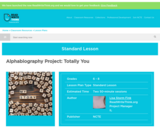
The traditional autobiography writing project is given a twist as students write alphabiographies - recording an event, person, object, or feeling associated with each letter of the alphabet.
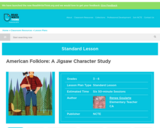
Groups of students read and discuss American folklore stories, each group reading a different story. Using a jigsaw strategy, the groups compare character traits and main plot points of the stories. A diverse selection of American folk tales is used for this lesson, which is adaptable to any text set.
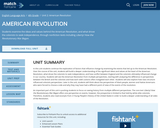
In this unit students continue the exploration of factors that influence change by examining the events that led up to the American Revolution. Over the course of the unit, students will build a deeper understanding of the significant ideas and values at the heart of the American Revolution, what drove the colonists to seek independence, and how conflict between England and the colonists ultimately influenced change in our country. Students will see the American Revolution from multiple perspectives, starting with analyzing the difference in perspectives between the British and the colonists and how each side’s actions often instigated each other. Students will also explore how class structure influenced colonists perspectives. Later in the unit, students will think about the perspectives of black people, women and Native Americans who were forced to choose a side and why they may have had a different point of view of the events of the revolution.
An important part of this unit is pushing students to focus on seeing history from multiple different perspectives. The core text Liberty! How the Revolutionary War Began offers one perspective on events, however, the prespective is limited to that held by white elite colonists. Therefore, students also read excerpts from A Young People's History of the United States in order to build a deeper understanding of all sides of the Revolution.
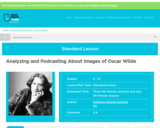
Students analyze images of Oscar Wilde used to publicize his 1882 American lecture tour. They then compare a caricature to another researched image, sharing this analysis in a podcast.
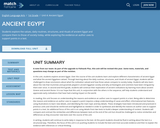
In this unit, students explore ancient Egypt. Over the course of the unit students learn and explore different characteristics of ancient Egypt and what the ancient Egyptians valued. Through learning about the daily routines, structures, and rituals of ancient Egypt, students will be challenged to draw conclusions about what the civilization valued and how those values compare to society today. Students will also learn about the role that mummies and pyramids played in ancient Egyptian society and why archeologists and scientists have been intrigued by them ever since. In second and third grade, students will continue their exploration of ancient civilizations by learning more about ancient Greece and ancient Rome. It is our hope that this unit, in conjunction with the others in the sequence, will help students understand and appreciate early civilizations that have had a lasting impact on the world.
In reading, this unit focuses on understanding the reasons and evidence an author uses to support points in a text. Being able to determine the reasons and evidence an author uses to support a point requires a deep understanding of cause and effect, informational text features, using illustrations to learn new details, and identifying the main topic and key details. These strategies have been introduced and practiced in previous units and should be reinforced and highlighted as needed in order to synthesize and identify the reasons an author uses to support points in a text. An additional focus of this unit is on using details from two texts to build a deeper understanding of content. Students will compare and contrast the similarities and differences between texts at the end of the unit but should be challenged to notice similarities and differences as they encounter new texts over the course of the unit.
In writing, students will continue to write daily in response to the text. At this point students should be fluid in writing about the text in a structured way. Therefore, the focus of this unit is on pushing students to include the best and most accurate evidence and then to explain the evidence with inferences or critical thinking.
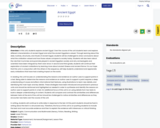
In this unit, students explore ancient Egypt. Over the course of the unit students learn and explore different characteristics of ancient Egypt and what the ancient Egyptians valued. Through learning about the daily routines, structures, and rituals of ancient Egypt, students will be challenged to draw conclusions about what the civilization valued and how those values compare to society today. Students will also learn about the role that mummies and pyramids played in ancient Egyptian society and why archeologists and scientists have been intrigued by them ever since. In second and third grade, students will continue their exploration of ancient civilizations by learning more about ancient Greece and ancient Rome. It is our hope that this unit, in conjunction with the others in the sequence, will help students understand and appreciate early civilizations that have had a lasting impact on the world. In reading, this unit focuses on understanding the reasons and evidence an author uses to support points in a text. Being able to determine the reasons and evidence an author uses to support a point requires a deep understanding of cause and effect, informational text features, using illustrations to learn new details, and identifying the main topic and key details. These strategies have been introduced and practiced in previous units and should be reinforced and highlighted as needed in order to synthesize and identify the reasons an author uses to support points in a text. An additional focus of this unit is on using details from two texts to build a deeper understanding of content. Students will compare and contrast the similarities and differences between texts at the end of the unit but should be challenged to notice similarities and differences as they encounter new texts over the course of the unit. In writing, students will continue to write daily in response to the text. At this point students should be fluid in writing about the text in a structured way. Therefore, the focus of this unit is on pushing students to include the best and most accurate evidence and then to explain the evidence with inferences or critical thinking.
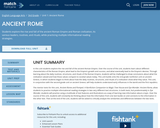
In this unit students explore the rise and fall of the ancient Roman Empire. Over the course of the unit, students learn about different characteristics of the Roman Empire, what lead to the Empire’s growth and success, and what eventually lead to the Empire’s demise. Through learning about the daily routines, structures, and rituals of the Roman Empire, students will be challenged to draw conclusions about what the civilization valued and how those values compare to societal values today. This unit builds onto the 2nd grade nonfiction unit on ancient Greece, in which students began to think about how the daily routines, structures, and rituals of a civilization show what they value. This unit, in conjunction with the second grade unit on ancient Greece, will help students understand early influences in the world and the first republics.
The mentor texts for this unit, Ancient Rome and Pompeii: A Nonfiction Companion to Magic Tree House and Eye Wonder: Ancient Rome, allow students to practice multiple informational reading strategies in two very different text structures. In both texts, but predominately in Eye Wonder, students will practice using a multitude of text features and illustrations as a way of learning new information about a topic. Over the course of this unit, students will constantly be thinking about how the information from one text builds on and connects to the information in the other text. Then at the end of the unit, students will be asked to critically analyze the similarities and differences between the two texts.
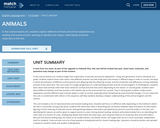
In this science-based unit, students begin their exploration of animals and animal adaptations. Using next generation science standards as a guide, students explore three main topics: how different animals use their body parts and senses in different ways in order to survive, the ways in which the behavior of different animal parents and offspring help the offspring survive, and the similarities and differences among individual animals of the same kind. This unit is part of a larger progression on understanding animals and the animal kingdom. In kindergarten, students learn about how animals meet their basic needs for survival and how that varies depending on the season. In second grade, students learn about different habitats and how animals in the habitat rely on the environment for survival. Then in third grade, students study animal adaptations and the different ways animals adapt in order to survive, especially when threatened by environmental changes. It is our hope that this unit, in combination with others in the sequence, will help students develop a deeper understanding of the animal kingdom and life science.
This unit includes a mix of read-aloud texts and shared-reading texts. Students will focus on different skills depending on the method in which the text is consumed. During read aloud, students will refine their skills in describing the connection between ideas and pieces of information, figuring out the meaning of unknown words, distinguishing between information provided by the pictures and information in the text, and identifying the reasons an author gives to support points in a text. During shared reading, students will predominately focus on identifying the main topic of a section of a text, retelling key details that match the main topic, and using text features to locate key facts and information. Because the shared reading days are meant to be student driven, not teacher driven, the target tasks are at a more accessible, independent level for students. There are also not a lot of key questions already planned for shared reading days. Questions should be written and spiraled in based on student needs and student reading levels.
In writing, this unit builds on the work students did in unit one. Students will continue to write daily in response to the text, with a focus on correctly answering questions and adding an inference or critical thinking.

Students will work with a partner to write, solve, check, and animate a division story problem based on a division expression using a sharing model.
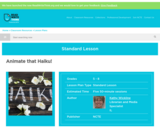
Following the traditional form of the haiku, students publish their own haikus using Animoto, an online web tool that creates slideshows that blend text and music.

A tool that helps students integrate text-based details/evidence into their speech and writing.
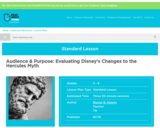
What drives changes to classic myths and fables? In this lesson students evaluate the changes Disney made to the myth of "Hercules" in order to achieve their audience and purpose.